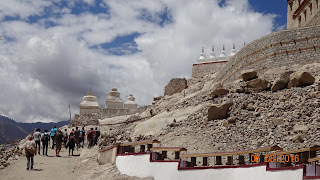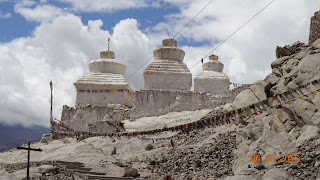08.08.16
That morning at 9.00, Yaseen, the driver reported promptly at the hotel with his Toyota SUV. Right from the very first day,
Yaseen became quite friendly with all of us. He was young, had a pleasing attitude and always smiled. He belonged to Ladakh itself and had been driving for more than 7-8 years in Ladakh areas, working for a local tour operator company. Only towards the end of our tour, we realized how much hard his job must have been, driving on the hilly routes, almost every day.
The morning breakfast was different – cutlet instead of bread pakora - and like the first day, very delicious. However, as we were advised to eat only moderately during the entire tour to avoid discomfort while traveling on high altitude hills, we restrained ourselves while eating the breakfast. We were also advised to carry water everywhere and drink frequently to avoid dehydration. We realized a little later that day why keeping the stomach light was very important to climbing the small hillocks, to reach the monasteries.
Our first visit was to Thiksay Monastery, located some 19 k.ms from Leh. Gompa is the Tibetan name for the monastery. Built originally during the 15th century and subsequently improved, and located atop a hill at a height of 11800 feet, Thiksay Gompa is a twelve story complex, the largest in Ladakh, and houses a number of items important to Buddhism. Stupas, statues, wall paintings, swords and Thangka hand painting etc. I have read that the Thiksay Gompa resembles the famous Lhasa monastery in Tibet. The temple for Maitreya, built during 1970 to commemorate the visit of the 14th Dalai Lama, housed inside the Gompa contains a 49 feet tall statue of Maitreya, covering two stories of the building. There is an entry fee of Rs.30 per person to visit the Gompa and temple.
 Pictures of Thiksay Monastery would speak for themselves about the beauty and elegance of the monastery.
Pictures of Thiksay Monastery would speak for themselves about the beauty and elegance of the monastery.
During our visit to Leh, we noticed that the entire Indus River Valley around Leh was preparing to hold the month-long celebration of Himalayan Kumbh Mela – the once-in-12-years religious and cultural event - sometime during September 2016, and hence, many monasteries and their related structures sported colorful flags, stupas, and welcome arches for the Holy Teachers.
On our way back, we stopped over at the Shey Gompa and Palace. Again, we had to climb a steep, sloping ramp, followed by several steps to reach the palace. During its early history, Shey happened to be the summer capital of Ladakh. Originally built in 1655 during the rule of the King Deldan Namgyal, the palace is now in ruins only. The monastery is noted for its giant statue of Shakyamuni Buddha, made of copper and gold plated. He is so named because Buddha was the sage of the Sakhya people who resided in the foothills of their capital city Kapilavastu.
Here are the pictures, taken at Shey Gompa and Palace.
From Shey Palace, we were driven to Leh Palace. The day was already very hot. The sun shone very brightly, blinding our eyes. Lights reflected from the barren rocks made it difficult to see anything without the aid of sunglasses.
Built during the 17th century by the King Sengge Namgyal, the nine storied Leh Palace sits atop another hillock, within the town of Leh. I heard that when the Dogra king’s forces took control of Ladakh during the 19th century, the royal Namgyal family abandoned the palace and moved to Stok Palace. Archaeological Survey of India is restoring the palace and maintaining it. There is a small entry fee of Rs.15 per person. One can have a panoramic view of the city of Leh from atop the palace. I climbed all the way to the 8th floor (but couldn’t find the way to the 9th), through small, narrow steps, while my wife stayed back on the 3rd floor itself, finding it difficult to climb the steps.
Here, I must mention about the Thangka (hand) paintings, a specialty of the Tibet regions. Painstakingly drawn by hand by the Tibetan Monks, they generally contain intricate designs and retain their bright and pleasing colors – the paint made from crushed and powdered gems and stones. Some of these painting are 3-4 centuries old. In the marketplace, many Thangka paintings are sold for fabulous prices, though most of them are not vintage ones. We bought two pieces which were only 9x9” in size costing Rs.1200 each. Larger sizes cost as high as Rs.20000 or even more.
The markets (including the Tibetan Refugee Market, supposedly, a janata market) also sell an assortment of bronze items (made in Nepal and Tibet) like Buddha statues, bells, bowls, etc., ornamental chains of gemstones of exotic colors, handicrafts, pashmina shawls and carpets. However, it looked they were all over priced, keeping in mind that after all, the market lasted only for four or five months in a year. I was particularly impressed by the bowl bells (of various sizes). You hold it in your open palm, gently strike the exterior with a small, rounded, wooden stick, and gently touching the edges of the bowl, keep rotating the stick around the edges in slow motion; soon, the continuous ringing of the primordial ‘Aum’ sound resonates from the bowl, as long you keep rotating the stick around it. Yet, the prices of these bowls were exorbitant, and hence, I decided not to buy one.
We were dead tired after climbing the Leh Palace and we decided to call it off a day. Thanks also due to the scorching sun. It was past 2.00 in the afternoon. We came to the market, had some lunch, returned back to our room, and slept away during the entire afternoon. That day evening was free for us and yet, we did nothing much except strolling around the nearby market. Yasin had earlier offered to take us to the Shanti Stoop, another Buddhist landmark, in the evening, but none of us were ready for another climb.
The menu changed again for the dinner; some nice soup, dhal, kadai vegetable, rice, fulka chapathi, salad, pappad and some sweets. Once again, we were cautioned against eating heavily, for we were to leave the next day morning to Nubra valley, (after vacating the room in Leh) passing through the highest motorable road in the world, at Khardung la (Pass) at 18380 feet.
With great expectations about the next day trip to Nubra valley, we went to bed.
… to be continued
























No comments:
Post a Comment